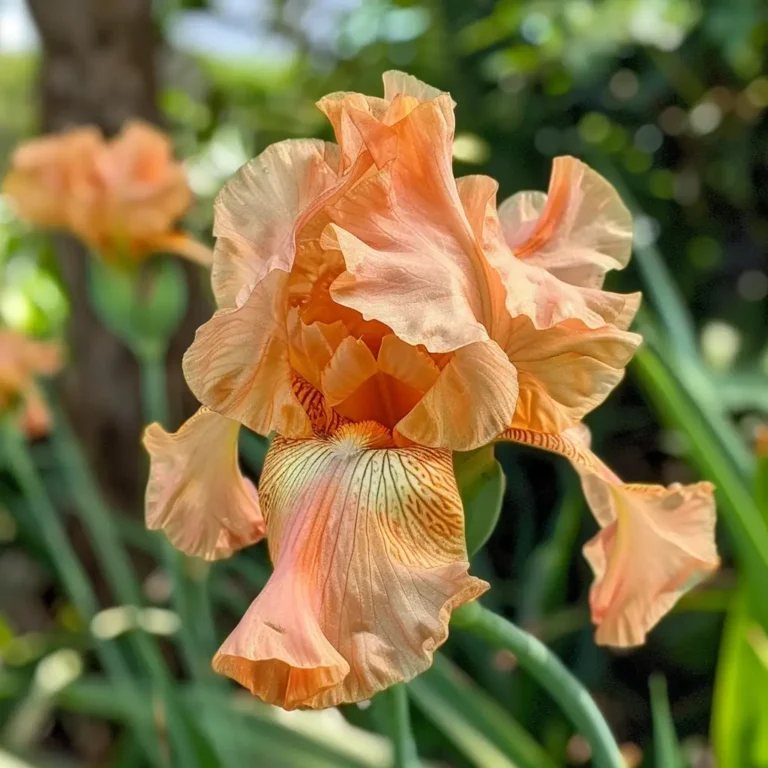Introduction to Sunset Glow Iris
The Sunset Glow Iris, known for its vibrant hues resembling a sunset, is a captivating addition to any garden. This perennial is celebrated not only for its stunning appearance but also for its ease of cultivation. Its striking flowers make it a favorite among gardeners and horticulturists alike.
Botanical Characteristics
Morphology
Sunset Glow Iris boasts a unique structure:
- Flowers: Large, showy blooms in shades of orange, yellow, and red.
- Leaves: Sword-shaped, vibrant green leaves that provide a lush backdrop.
- Stem: Tall and sturdy, often supporting multiple blooms.
Habitat and Distribution
This iris thrives in temperate climates, often found in regions with well-drained soil and ample sunlight. It is native to various parts of Europe and North America.
Growth and Lifespan
With proper care, the Sunset Glow Iris can thrive for many years:
- Lifespan: Typically lives for 5-10 years.
- Growth Rate: Moderate growth, reaching full maturity in about 2-3 years.
Cultivation Practices
Soil Requirements
For optimal growth, the Sunset Glow Iris prefers:
- Soil Type: Well-drained, slightly acidic to neutral soil.
- pH Level: Ideal pH range is 6.0 to 7.0.
Watering and Fertilization
Consistent care is crucial:
- Watering: Regular watering, especially during dry spells, but avoid waterlogging.
- Fertilization: Use a balanced fertilizer in early spring and after blooming.
For more detailed guidelines, refer to the Royal Horticultural Society’s Iris Care Guide.
Pests and Diseases Management
Common issues and solutions include:
- Pests: Aphids and iris borers are frequent pests.
- Diseases: Monitor for fungal infections like leaf spot and rot.
- Prevention: Ensure good air circulation and avoid overwatering.
Propagation Techniques
Seed Propagation
Although less common, seed propagation is possible:
- Method: Collect seeds after flowering, plant in a seed tray with well-drained soil.
- Care: Keep the soil moist and place the tray in a sunny location.
Division and Rhizome Propagation
The most popular method for Sunset Glow Iris:
- Timing: Best done in late summer or early fall.
- Process: Divide the rhizomes, ensuring each section has healthy roots and a fan of leaves.
Best Practices for Successful Propagation
- Preparation: Prepare the new planting site beforehand.
- Planting Depth: Plant rhizomes just below the soil surface.
Landscape and Garden Uses
Aesthetic Appeal
The Sunset Glow Iris enhances any landscape with its:
- Colors: Vibrant and eye-catching blooms.
- Texture: Adds variety to garden textures.
Companion Planting
Ideal companions include:
- Plants: Daylilies, ornamental grasses, and other perennials.
- Benefits: Creates a diverse and visually appealing garden.
Seasonal Considerations
- Spring: Planting and early growth.
- Summer: Peak blooming period.
- Fall: Propagation and preparation for dormancy.
For more tips on integrating irises into your garden, visit the American Iris Society – Growing Irises.
Popular Varieties and Hybrids
Overview of Varieties
Several varieties of Sunset Glow Iris are popular among gardeners:
- Variety A: Known for its deep orange petals.
- Variety B: Features a mix of yellow and red hues.
- Variety C: Distinguished by its bi-color blooms.
Notable Hybrids
Hybridization has produced some stunning options:
- Hybrid X: Enhanced disease resistance.
- Hybrid Y: Longer blooming period.
Selection Tips for Gardeners
When selecting a variety:
- Climate Compatibility: Choose varieties suited to your local climate.
- Garden Aesthetics: Consider color schemes and plant height.
Sunset Glow Iris in Floral Arrangements
Techniques for Cutting and Arranging
To create beautiful floral arrangements:
- Cutting: Harvest blooms early in the morning.
- Arranging: Combine with complementary flowers like lilies and roses.
Longevity and Care in Vases
To extend vase life:
- Water: Change water every two days.
- Placement: Keep away from direct sunlight and drafts.
Popular Uses in Events and Ceremonies
- Weddings: Frequently used in bridal bouquets and centerpieces.
- Special Occasions: Ideal for adding a touch of elegance to any event.
Environmental and Ecological Impact
Role in Native Ecosystems
The Sunset Glow Iris plays a vital role in:
- Pollination: Attracts bees, butterflies, and other pollinators.
- Biodiversity: Supports local flora and fauna.
Benefits to Pollinators
- Nectar Source: Provides a rich nectar source for pollinators.
- Habitat: Offers shelter for various insects.
Environmental Concerns and Mitigations
- Invasiveness: Monitor for signs of spreading beyond intended areas.
- Sustainability: Practice eco-friendly gardening to minimize environmental impact.
FAQs
Common Questions from Gardeners
What is the best time to plant Sunset Glow Iris?
- Plant in late summer to early fall for optimal root establishment.
How do I prevent diseases in my Iris plants?
- Ensure good air circulation and avoid waterlogging to prevent fungal infections.
Can Sunset Glow Iris grow in containers?
- Yes, with adequate drainage and regular care.
What are the light requirements for Sunset Glow Iris?
- Prefers full sun but can tolerate partial shade in hotter climates.

